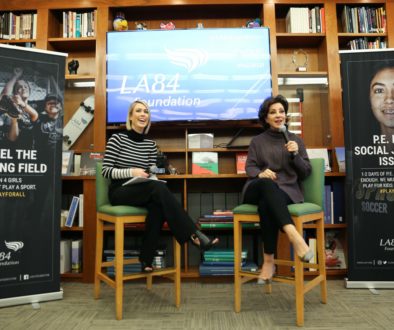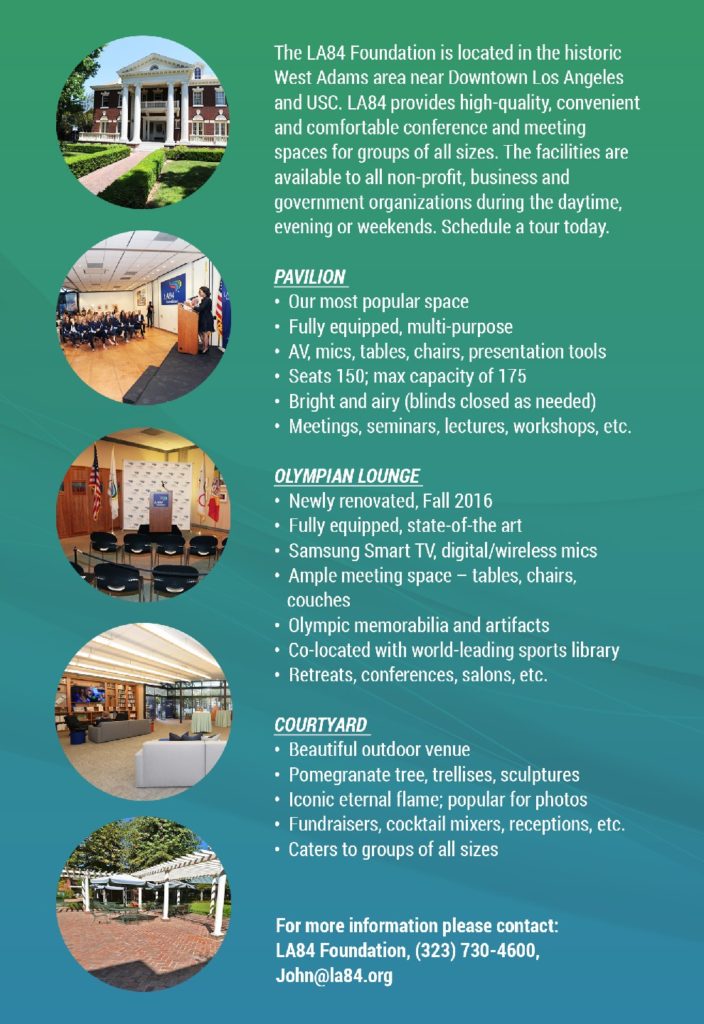SL Interview: Michael Messner Talks About His New Book on Youth Sports
A professor of sociology and gender studies at the University of Southern California, Michael Messner has long studied sports through the lens of gender identity. His books include “Taking the Field: Women, Men, and Sports,” “Out of Play: Critical Essays on Gender and Sport,” “Power at Play: Sports and the Problem of Masculinity,” and the widely-used textbook “Men’s Lives” (now in its eighth edition).
With his latest book, “It’s All for the Kids: Gender, Families, and Youth Sports” (University of California Press; Amazon), Messner turns his attention to youth sports. He believes the subject is ripe for study, not least because “two-thirds of American youth are currently involved in at least one organized or team sport,” he writes. He also notes that, in academic circles, “there have been very few book-length studies of youth sports – despite the fact that this is where we find the largest number of participants at any level of organized sports (excepting spectatorship).”
Messner took eight years to research and write “It’s All for the Kids,” drawing in no small part on his personal experience as a volunteer assistant coach-scorekeeper for his two sons’ AYSO soccer and Little League baseball teams in their hometown community of South Pasadena, Calif. The wide-ranging book examines every aspect of this culture, including the “glass ceiling” women face within the coaching and volunteer ranks, the separate-but-not-always-equal division between girls and boys teams, and what Messner describes as the “gender comfort zone” within youth sports.
SportsLetter recently spoke with Professor Messner in South Pasadena.
— David Davis
SportsLetter: You researched this book in South Pasadena, where you live and where your kids played on various baseball and soccer teams. What do youth sports mean in this community?
Michael Messner: Youth sports are huge in South Pasadena. It’s one of the first things that my wife and I discovered when we moved here. At that point, we had a four year-old and a one year-old, and our neighbors told us, “You’re going to be getting into Little League, and soccer and YMCA basketball.” Sure enough, when our kids got to the age of entering Little League and soccer, we got them involved in that.
You can see the importance of youth sports to the community just by going to the annual opening ceremonies for the AYSO league. It’s a gigantic ritual, an event where community officials and Congressman [Adam] Schiff come. Each team has a banner that they march behind around the high school track. The adults who aren’t marching with them sit in the stands and applaud. It almost feels like the Fourth of July parade – it’s maybe even bigger.
In South Pas, youth sports is one of the main ways that community says to itself, “We really care about our kids and the kids are our top priority here in town.” The community sees youth sports as a way to make the town a safe, cozy place for kids. It’s also one of the main ways that parents volunteer to be involved with their kids, in particular for the dads because the moms are heavily involved in a wide range of volunteer activities. So, youth sports has a lot of meaning in terms of providing a sense of cohesion and safety in the town.
SL: Does South Pasadena reflect national trends about the significance of youth sports in community?
MM: I think so, at least in so far as it’s reflective of national trends in suburban areas. Youth sports in inner cities has a different texture and different meaning. I haven’t really studied that. This has to be taken as a study of a middle-class, bedroom community outside an urban area.
SL: Why did you decide to focus on your own community?
MM: I started this research with the observation that, I couldn’t find very many women coaches in youth sports in South Pasadena. I was stunned to find that. I tried to find national numbers, to find out whether South Pasadena was reflective of the national numbers, but AYSO and Little League told me that they don’t keep statistics on the sex of their coaches. So, the next best thing for me to do was to try and find numbers on local, surrounding communities. Of the ones I could get information on, South Pasadena had a higher proportion of women coaches than in any of those communities. Some of them had zero women coaches.
SL: You point out that two-thirds of American youth are involved in organized sports. How did we get to this point?
MM: There’s just more sports and more leagues now. When I was a kid, there was basically Little League baseball for boys. There was the beginnings of AYSO soccer and Pop Warner football, and that was it. Of course, part of the boom has to do with the movement of girls into youth sports. It’s now seen as something that all kids do, which I think has really opened it up.
I think it also fits with a lot of social trends since the 1960s and 1970s. During the Kennedy and Johnson administrations, there was the concern that kids were getting soft – that we had to “muscle up” the kids (meaning boys back then) – in the context of the Cold War. That fueled physical activity and sports as a nationalistic tendency. There’s also been a lot of concern about kids and health – and, more recently, about kids and obesity – and the idea that lifelong physical activity is a good thing and that sports is a way to usher in kids to that. So, I think that’s behind the push and expansion of, and the parents’ enthusiasm of, organized youth sports.
There are other cultural issues, in particular the escalating fears we have for our kids – that our kids are not safe in this world. Several adults in this study talked about their childhoods wistfully, about going to the park by themselves or wandering in the Arroyo by themselves, and how they would never let their kids do that today.
So, youth sports has become part of the more general over-organization of kids’ lives by adults, particularly in middle-class and professional communities. We’re constantly ferrying our kids from tutors to music lessons to Scouts to sports teams to private coaches. That fits in with the idea that we have to perfect our kids, this escalating sense that we have to prepare our kids to have the well-rounded resume to get into the right kindergarten, the right high school, the right college. And, sports is part of that. It’s not enough to get them into sports; we have to hire private coaches and batting instructors.
SL: Title IX is often cited as the impetus for the increased integration of girls and women into sports in America. Where do you see the most gains for girls and women – among the athletes themselves or in the coaching ranks?
MM: Oh, there’s been enormous gains in terms of athletic participation for girls. If you look at the numbers, from the 1960s and the beginning of the 1970s, there were few opportunities for girls to play sports. By the late 1970s, you see this steep incline in participation for girls. It’s continued to increase, not quite at the rate it did in the late 1970s, but at every level, from youth sports to high school to college.
The irony is that, whether you’re looking at college or youth sports, there hasn’t been that same proportionate growth in women coaches. It’s actually the opposite for colleges: the percentage of women’s college teams that were coached by women, pre-Title IX, was about 90 percent. Now it’s about 50 percent, and you’ve seen men flow into coaching college women. With youth sports, you see a trickle of women moving into coaching. So, it’s doesn’t at all mirror the huge numerical increases of girls’ participation.
SL: Why is this divide happening?
MM: That’s the question that got me into the whole study: why, in this day and age, do we see so few women coaches in youth sports? Why is this happening now, despite the fact that many women today are post-Title IX mothers who have a lot of athletic experience and whose own daughters are now playing sports?
I approached that question, first, by collecting numbers and looking at what I saw going on around me, and then taking field notes and doing interviews. What I found was that, when people in South Pasadena talk about why men become coaches and why women become “team moms,” they talk about this as if it were a free choice – like anybody can be a coach. It just so happens that, when we call for volunteers, the men volunteer to be coaches and the women volunteer to be team moms. It just works out that way.
When I started looking deeper into this, I saw that there were some women who initially wanted to be coaches but became team moms instead. That was very interesting to me: What happened and why did they get channeled away from being coaches?
I went to a lot of start-of-the-season team meetings over the course of several years. What I saw so many times was, when a male parent volunteered, he was immediately assigned to be a coach. When a female parent volunteered, she was assigned to be a team mom. One woman told me that she had signed up to be a coach. Then, when she showed up at the initial meeting, the coach re-assigned her to be the team mom.
The result is, if you think of the coaching system in youth sports as a pipeline, the way people become head coach is by starting as an assistant coach. Because women are getting routed away from being assistant coaches, they’re not in the pipeline to become head coaches.
SL: You point out that there are more women coaches in AYSO than in Little League baseball and softball. How do you account for this difference?
MM: It’s partly that baseball and, by extension, softball in the United States belongs to the men. Most of the male coaches I encountered grew up playing Little League – some right here in this community. Some of them played high school baseball; one or two played at a higher level. They feel like they know the game. They do know the game.
There’s a real sense that baseball is a man’s realm and, interestingly, a lot of women feel the same way. They told me that they wouldn’t presume to coach baseball. Some of them say the same thing about softball, even though they played softball, because they feel this sense of ownership from the men.
The other part of it is, soccer is a much newer game here. Many adults didn’t play a lot of soccer as kids, although that will change in a few years. So, the men don’t have this sense of knowing it and owning it.
There’s evidence in the world of work that when women move beyond mere tokenism they can start collectively supporting each other and recruiting new women and creating contexts more friendly for women. I think the same is happening in AYSO to some extent. I found that, in the last few years of this study, as the number of women soccer coaches increased, they were able to identify mentors above them and talk about recruiting new women coaches. For part of the time of my study, one of the heads of the AYSO league was a woman who had come from the coaching ranks. There’s none of that in baseball or softball.
SL: Has the public success of women soccer players, in the World Cup and in the Olympic Games, contributed to this?
MM: It might be, although none of that surfaced in my interviews. But those broader symbolic contexts are important, including the mass-media images of successful women soccer players on the world stage. That certainly helped to create a surge of girls going into soccer. And, although there have been some really successful women softball players, the sport hasn’t been as highlighted in the media as the soccer has been.
SL: How were women coaches treated, in general, in South Pasadena?
MM: Several of the women we interviewed said they got into coaching soccer because they were recruited by a man and mentored by a man. I think the more general feeling they got from the men coaches, though, was that they’re not fully welcome. Or, the men don’t know how to talk to them. The men sometimes don’t share some of the informal information that they might share with some of the male coaches.
Again, I don’t think this was conscious. I don’t think the men were saying, “Let’s get the women out.” I think it’s more of a sub-conscious level of discomfort. When you’ve been in a realm like sports all your life and you’ve always been used to being around guys, you learn to relate to guys in a certain way. When a woman comes in as a peer, you don’t know what to do with it. I’m pretty sure that’s it’s more that than anything. But the net result is women end up feeling marginalized.
They’re also treated differently by the parents. They come in and face immediate questions: Is she qualified? Why should she work with my kids? There’s a sense of extra scrutiny from the parents, and especially from the fathers. They’ll come up and directly challenge the coach’s knowledge and capability in a way they wouldn’t with a male coach. They’ll say, “What’s your background? Is that drill approved by AYSO?”
SL: How do men approach coaching youth sports in South Pasadena?
MM: Some of them see it as a sort of currency. It enhances their professional and social status to say that they’re coaching their son or daughter’s team. Which isn’t to say that that sort of involvement isn’t a good thing. It’s good to see fathers involved with their children’s lives and the sense of caring they bring to this.
I think that men bring to the experience of coaching an unspoken sense that they know what they’re doing. Other parents treat them as though they know what they’re doing. In other words, men are given a pass at first because people assume they have the background and knowledge. Of course, they can prove people wrong. They can be incompetent or not know the game or be overbearing and not capable of working with kids.
At the same time, one of the interesting things I found in this study was that a lot of men expressed insecurity about coaching. Especially among the head coaches, because they knew that they were going to be scrutinized by the community. They’d tell me, “If you don’t yell at the games, parents think that you’re disengaged and you don’t care. If you yell too much, people get really upset because they don’t want you yelling at their kids.”
SL: How does coaching kids of different ages influence the behavior of coaches?
MM: I break it down to “kids knowledge” versus “sports knowledge.” At the entry level, there’s a high emphasis on “kids knowledge.” That’s part of what creates openings for women and for men who aren’t necessarily hyper-competitive. As you move up in the age levels, the emphasis becomes more on “sports knowledge.” The term that everybody uses when they describe it is “serious.” What “serious” means is, more emphasis on winning, more emphasis on competition, more emphasis on kids playing a particular position rather than trying out different things, more emphasis on the stars of the team getting more playing time and the more marginal kids not as much, more emphasis on the coaches controlling things a lot more.
That’s where you see women coaches being pushed out or just deciding to leave. They told me, “I can’t make myself act like that. I can’t yell like these guys. I’d rather coach the young kids or not at all.”
SL: In the book, you write that most of the people you surveyed believe that it’s preferable for boys to be coached by men rather than women. Why is that?
MM: There’s different pieces to it, but I think it all comes down to that fact that people have a very simplistic view of boys. Feminism hasn’t radically altered the way we think about boys, which is that they’re just wild, full of testosterone and super competitive. Sports is a place where boys are thought to be naturally suited.
With coaching, there’s a sense that boys, in their daily lives, are not around men that much. Their mom’s at home a lot of the time. Their teachers are women. So, there’s this idea that boys need male role models in their lives. There seems to be an underlying fear that, if boys don’t have men in their lives, they’ll face a more troubled future. Like, how will they be able to become “real men”?
Whereas, we have a much more complex view of girls. Because of feminism, we’ve broadened our sense of what girls are and what they face in the world and how sports allows girls to develop in ways that help them navigate the world they’re moving into. Parents love sports for girls, and most of them don’t particularly see any value to having a male coach or a female coach. There was a lot more openness about whether men or women should coach girls.
SL: You point out that, for the most part, boys and girls play on separate teams and in separate leagues. Is that sort of segregation healthy or unhealthy?
MM: I’m not of a single mind about this. I think it’s really good for boys to experience athletic girls and to understand that girls can make the play. That’s important because, as they grow older, boys are going into a world where they’ll work side by side with women and where women are their bosses. It’s really important that they develop a sense of respect of women and learn that women can be leaders and competitive and strong. And, sports is where they can learn a lot of that stuff.
It’s trickier when you think about the girls’ side of it. We’re still living in a world where, from the earliest age, boys are ushered into sports with much more enthusiasm. By the time they get to the grade school age, boys have more experience and support and enthusiasm for being athletes than girls do. What I would fear is that, if we forced the integration of youth sports, we would push girls out of sports.
So, I think it’s good to have separate leagues for girls because it gives them the opportunity to have the full sports experience. What’s bad is when you have girls who are really good athletes and want to play with the boys. For instance, girls went to the Supreme Court to win the right to play Little League baseball, but the vast majority of them are shunted off to softball. A lot of girls don’t know that they’re allowed to play baseball against the boys if they want to.
SL: Does youth sports contribute to breaking down gender inequalities or to reinforcing them?
MM: Yes and no (laughs). I think the movement of girls and women into sports over the last 30 years or so has done a lot to challenge this idea of the separation between boys and girls and men and women. That’s what is known as “hard essentialism” – the belief that men are athletic; women are not. Men are strong; women are weak. That sort of dichotomization can’t stand up to scrutiny anymore, and that’s partly because there’s girls and women out there playing sports.
On the other hand, I think the way we organize sports continues to channel boys and girls in different directions. We treat them differently. We talk about them differently. We coach them differently. Sports has become a place where we’re still shaping gender and gender differences in certain ways – but it’s not the same way we shaped it in the 1950s and the 1960s, when it was just all boys. It’s shaping gender in a world where girls are now included and it’s shaping gender in a world where those girls’ mothers have had opportunities for college and for working professions.
So, it’s a more complicated world of gender relations than existed before. It goes back to Sociology 101: Sport reflects society and it re-enforces society. It reflects the things that are going on more generally in the world and it’s also helping to create them at the same time. And, for kids, sport is an important part of how we make sense of the world.
SL: You write that youth sports has become a kind of gender “comfort zone”? What do you mean by this?
MM: My initial interest in this topic, however many years ago, was, “What do we make of the fact that women are moving into sports in such great numbers?” It seemed to be the opposite of this whole notion that was around when I was growing up, that sports make men and men make sports. With youth sports, I came back to this same core question: What is sports doing for gender relations today?
What I observed in youth sports is that, despite the integration of girls into sports, we’ve segregated them. At the same time, the meanings that we spin around boys and girls are pretty conventional. There’s this sense of relief that, even though girls are playing sports now, adults can think of boys and girls as very different.
We’re living in an era of an unfinished feminist revolution. It’s an incomplete revolution. A lot of things have changed, but a lot of things haven’t. You have married women with double-work days and facing the glass ceiling in the workplace. I think the way we talk about our kids and treat out kids in sports is a way to confirm for ourselves, the adults, that some of the gender dichotomized choices we’ve made in this supposedly post-feminist world are natural.
SL: Was there anything that surprised you in your research?
MM: I was surprised by how many of the men expressed insecurity about coaching, despite their vast sports experience. Guys put up such a good front: their body posture, their clipboards. They seem to be in total control. But when you talk with them, they talk about how much they struggle with their confidence.
SL: What do you feel should be done to improve youth sports?
MM: I’d have more public dialogue about loosening up the boundaries between girls and boys playing sports together. In particular, letting girls know they can play baseball if they want to.
I would encourage more formal recruitment of women coaches – more outreach to women who are interested in coaching — rather than leaving it up to informal recruitment. And, I’d have more formal mentoring of new coaches, for women and men, which I think would be a great benefit to everybody.
AYSO does a reasonably good job of having workshops for coaches who want to go to the next level. Some of the women who moved up in AYSO credit that with helping them. Little League baseball doesn’t do that. You’re basically thrown out there on your own.
SL: The title of the book is “It’s All for the Kids.” Is youth sports all about the kids?
MM: I like my book titles to have some sort of double entendre. On the surface level, when you look at the culture of youth sports in South Pasadena, there’s this sensibility that we’re doing all this for the kids and that we create this safe haven of youth sports all for the kids. It’s not that that’s not true. But when you look at what a lot of us are doing, it’s also about our own sense of identity, as parents, and our sense of social status in this community. It’s about us, too.
SL: What was it like to interview and report on people who are your neighbors?
MM: In most ways, it was great. I thought of this as participant-observation research, where I was an assistant coach and scorekeeper on my sons’ teams. I tried to remember to tell the head coaches that I was doing this study and that anything they said would possibly end up in my field notes.
As you know, I take a very critical orientation toward inequality in sport. I look at these issues with a critical eye. But having my kids involved, I could see and experience the really good stuff that kids are getting from being involved in youth sports and the high quality of mentoring they get from a lot of the coaches. Being a member of the community helped me experience the positive side to counter my tendency to be overly critical. It gave me a sense of responsibility to report as carefully and clearly as I could on what I saw.
SL: How do you think the community will react to your findings in the book?
MM: I know that some people are hoping that this will be a big expose because there are some women who are very angry about the way they feel women coaches are treated within youth sports in South Pasadena. Some of them are angry about the way their daughters are treated here. They feel they’re limited in certain ways. They’re looking at this book as a tool that they can use to open up dialogue.
I suspect that other people who read it will feel uncomfortable about some of the content. Most people in South Pasadena see themselves as inclusive and want to see themselves as inclusive. Some of the stuff I’m pointing out in the book is about the unconscious tendencies that we all share that exclude others without realizing it.




